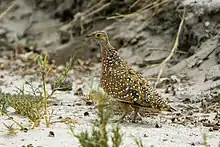Burchell's sandgrouse
Burchell's sandgrouse (Pterocles burchelli) is a species of bird in the family Pteroclidae. It is found in arid and semi-arid regions of southern Africa. The name of this bird commemorates the English naturalist William John Burchell.[2]
| Burchell's sandgrouse | |
|---|---|
 | |
| male | |
.jpg.webp) | |
| female | |
| Scientific classification | |
| Domain: | Eukaryota |
| Kingdom: | Animalia |
| Phylum: | Chordata |
| Clade: | Dinosauria |
| Class: | Aves |
| Order: | Pterocliformes |
| Family: | Pteroclidae |
| Genus: | Pterocles |
| Species: | P. burchelli |
| Binomial name | |
| Pterocles burchelli Sclater, WL, 1922 | |
Description
Burchell's sandgrouse is a plump bird about the size of a pigeon with a small head and short legs. The body is light brown, mottled with darker shades and white speckles. In males, the eye is surrounded by bare yellow skin and the cheeks and throat are pale grey. The male grows to about 25 cm (10 in) long and the female is a little smaller.[3]
Distribution and habitat
Burchell's sandgrouse is found in Angola, Namibia, Botswana, Zambia, Zimbabwe and South Africa. It is normally resident but moves about to a limited extent depending on the availability of water and the seeds it mainly eats. It is widespread and common in much of its range.[4] It frequents areas of rough grass and scrub, especially on red Kalahari sand and has been able to extend its range because of the greater availability of water after the sinking of boreholes by farmers.[5]
Burchell's sandgrouse is limited by water availability, like many of the other species residing in arid desert environments. This limitation of water is especially hard to overcome for Burchell's sandgrouse chicks that have little mobility to get water for themselves. However, one adaptation that adult Burchell's sandgrouse have developed is the transport of water in body feathers from a water source back to the nest to water their chicks. Upon getting to a water source, adult Burchell's sandgrouse rub their bellies on dry ground in order to ruff up their belly feathers to increase the amount of water the feathers can hold. They then wade into the water and bob up and down on a horizontal axis to soak up the water in their belly feathers, being careful to hold their wings above the water in order to not impede flight. Males have been observed to hold an average of 22 milliliters of water, while females carry an average of 9 milliliters. Once the water is gathered, Burchell's sandgrouse fly back to the nest and allow the chicks to drink the water off their belly feathers. [6]
Breeding
Burchell's sandgrouse is monogamous and breeds during the dry season between April and October. The nest is formed in a shallow depression in the ground often concealed among grass tussocks or under a bush. It is lined with a few fragments of dry vegetation and two or usually three eggs are laid. Both parents incubate the eggs and the chicks are precocial when they hatch, covered in down and soon able to run after the adult birds. Both parents care for the young and, as in other sandgrouse species, water is brought to them absorbed in the specially adapted feathers that line the parents' breasts.[5]
References
- BirdLife International (2016). "Pterocles burchelli". IUCN Red List of Threatened Species. 2016: e.T22693032A93379881. doi:10.2305/IUCN.UK.2016-3.RLTS.T22693032A93379881.en. Retrieved 13 November 2021.
- Beolens, Bo; Watkins, Michael (2003). Whose Bird? Men and Women Commemorated in the Common Names of Birds. London: Christopher Helm. p. 72.
- "Burchell's Sandgrouse". BirdForum. Retrieved 2012-06-05.
- BirdLife International 2004. Pterocles burchelli. 2006 IUCN Red List of Threatened Species. Archived June 27, 2014, at the Wayback Machine Downloaded on 24 July 2007.
- "Pterocles burchelli (Burchell's sandgrouse)". Biodiversity Explorer. Archived from the original on 2014-05-04. Retrieved 2012-06-05.
- MacLean, Gordon L. (1983). "Water Transport by Sandgrouse". BioScience. 33 (6): 365–369. doi:10.2307/1309104. ISSN 0006-3568.
External links
- Burchell's sandgrouse - Species text in The Atlas of Southern African Birds.
